
Born around 69 BC, Cleopatra VII Thea Philopator, popularly known as Cleopatra, is one of the most famous female rulers in history. She was the last queen of the Macedonian dynasty that ruled Egypt, following the death of Alexander the Great. The Ptolemaic dynasty in ancient Egypt began when Alexander's general, Ptolemy, took over as the ruler of Egypt and declared himself as ‘King Ptolemy I Soter of Egypt’, (saviour of Egypt). During its height, Ptolemaic Egypt was one of the world's great powers. Cleopatra was born to Ptolemy XII Auletes, in 70 or 69 BC. Details about her mother are not very clear, however, it is presumed that, she may have been her father's sister, Cleopatra V Tryphaena.

After the death of her father in 51BC, the Egyptian throne passed to 18-year-old Cleopatra and her 10-year-old brother, Ptolemy XIII. It is possible that, the two siblings married, as was the custom of the country. However, within no time, Cleopatra dropped the name of Ptolemy XIII from all official documents, and started to rule the country alone. But soon, Ptolemy’s advisers also started to play against Cleopatra, and finally, she was forced to flee Egypt for Syria in 49 B.C. While in exile, Cleopatra assembled an army of mercenaries and returned the following year to face her brother at Pelusium, on the eastern border of Egypt.

At about this same time, the Roman general Pompey the Great was defeated by Julius Caesar at the Battle of Pharsalus. Since Pompey was once the state-appointed guardian of the younger Ptolemy children and had spent a considerable time in Egypt, Pompey was under the impression that he can safely take refuge in Egypt. So he fled from Pharsalus to Egypt. However, instead of safety, he was murdered under the gaze of Ptolemy XIII, as he came on shore at Alexandra. But, Caesar was not happy at this. He was allegedly outraged at the killing of a Roman general, declared martial law, and set himself up in the royal palace. Ptolemy XIII fled to Pelusium with his court, but Caesar brought him back to Alexandria.

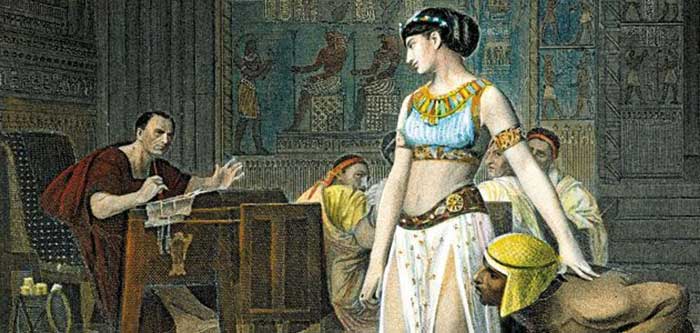
Caesar had the intention to recover the money, the repayment of the debts incurred by Cleopatra’s father, Auletes, as he struggled to retain his throne. On the other hand, Cleopatra knew that, if she was to regain her throne, she must have Roman support, or, more specifically Caesar’s support to defeat her rival brother. She was confident and clever enough to use her sexual charm and intelligence to woo her potential allies. She knew that she only needs the access to Caesar if she was to regain her power. She was still in exile and knew that, there was no way she could simply walk into the palace and meet Caesar directly. So she wrapped herself in a carpet, or a linen sack, and carried through the enemy lines into Caesar’s quarters. Caesar was instantly dazzled by the glamour and beauty of the young queen in her royal garb, and the two soon became allies and lovers. Eventually, she became Caesar’s mistress and gave birth to their son Ptolemy Caesar in 47 BC, nine months after their first meeting. He was nicknamed Caesarion, means ‘little Caesar’.
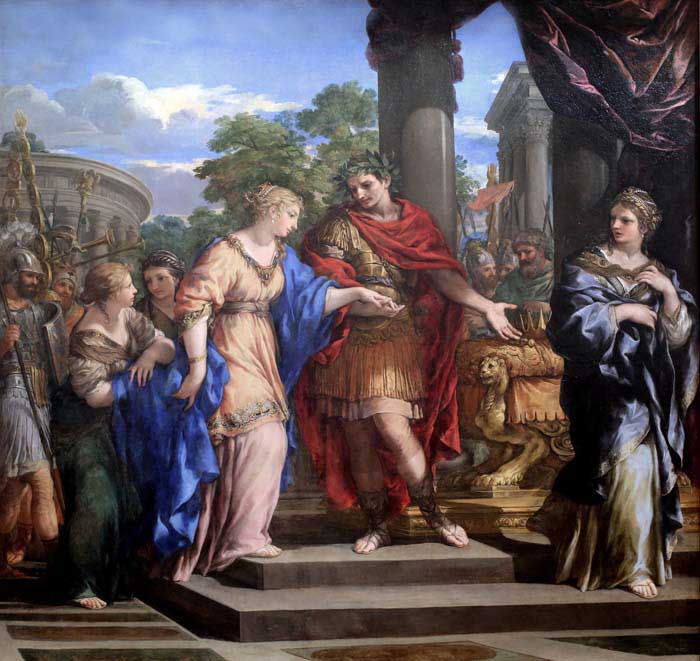
Ptolemy XIII, in the mean time, teamed with his general, Achillas, to fight against the Roman force in Alexandria. Caesar and Cleopatra had to spend the winter besieged in the royal palace of Alexandria for six months, until Roman reinforcements arrived the following spring. At the end of the war, Ptolemy XIII was forced to flee and was believed to have drowned in the Nile. Cleopatra, now married to her brother Ptolemy XIV, was restored to her throne by Caesar.
Before leaving Egypt, Caesar stationed a Roman occupying army there of three legions under the command of Rufio. As he returned to Rome, in 46 bce, he celebrated a four-day triumph, the ceremonial in honour of a general after his victory over a foreign enemy, in which Arsinoe, Cleopatra’s younger and hostile sister, was paraded.
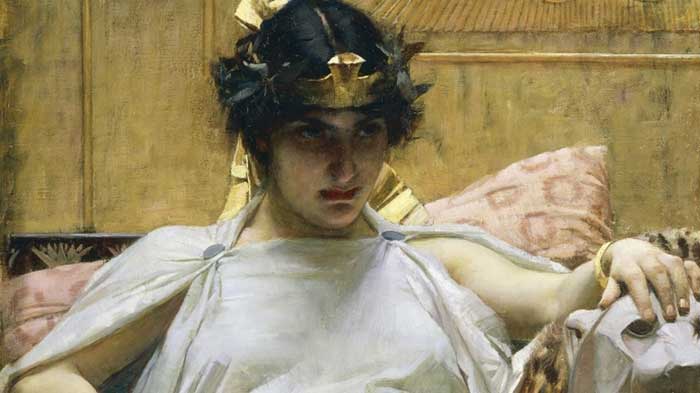

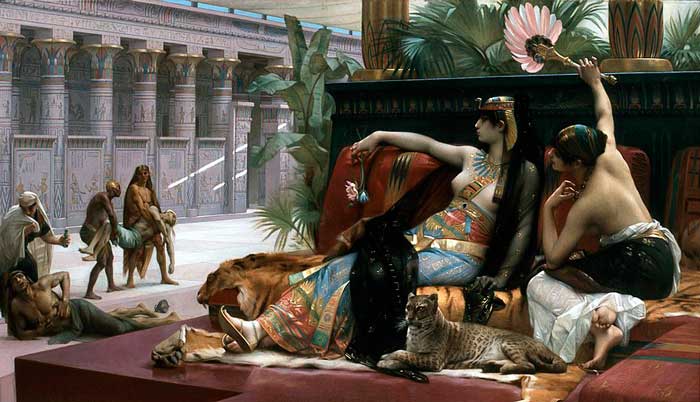
Cleopatra traveled to Rome with Ptolemy XIV and Caesarion to visit Caesar, sometime in 46-45 BC. However, the relationship between Cleopatra and Caesar caused a scandal among the Romans, as Caesar was already married to Calpurnia. As a foreign head of state, Cleopatra was not even allowed inside Rome's Pomerium. Instead, she was accommodated in one of Caesar's country houses, beyond the Tiber River. Yet, Caesar erected a golden statue of Cleopatra representing her as the goddess Isis, in the temple of Venus Genetri, the mythical ancestress of Caesar's family, situated at the Forum Julium. Cleopatra was still in Rome, when Caesar was assassinated on the 15th day of March, 44 BC, and after his death, she returned to Egypt with her brother-husband and son. Ptolemy XIV died soon after, allegedly poisoned by Cleopatra and the three-year-old Caesarion was named co-regent with his mother, as Ptolemy XV. At this point, in accordance with the ancient Egyptian tradition of associating royalty with divinity to reinforce the position of kings and queens, Cleopatra had strongly identified herself with the goddess Isis, the sister-wife of Osiris and mother of Horus.

At that point of time, an internal conflict was brewing in Rome between Caesar’s allies, comprising of Mark Antony, Octavian and Lepidus, and his assassins, Brutus and Cassius. Finally, in 42 B.C, after defeating the forces of Brutus and Cassius in the battles of Phillippi, Mark Antony and Octavian divided power in Rome. Mark Antony, controller of Rome’s eastern territories, soon summoned Cleopatra to the Sicilian city of Tarsus, in the south of modern Turkey, to answer questions about her loyalty. It was alleged that, during the Roman civil war, she had paid much money to Cassius. But, in all probability, Antony wanted Cleopatra’s promise to support his intended war against the Parthians.
This time again, Cleopatra exploited her sharp intelligence and lethal feminine charm to cast her magic spell on Mark Antony. According to the Greek biographer Plutarch, when she was summoned to meet Antony, Cleopatra arrived on a majestic golden barge decorated with purple sails and rowed with silver oars. Looking gracefully dignified in the attire of the goddess Isis, Cleopatra was beneath a gilded canopy in the barge, while the attendants dressed as cupids, were engaged in fanning her and burning sweet-smelling incense. Antony, who considered himself as the Greek deity Dionysus, was instantly mesmerized by the exotic beauty of Cleopatra.

The legendary love affair between Cleopatra and Mark Antony began in 41 BC. However, their relationship was based on their political interests. Cleopatra needed the assured assistance from the Roman General to protect her crown and the return of Egypt's eastern empire, which included large areas of Lebanon and Syria. On the other hand, Antony needed her support in his intended war against the Parthians and at the same time, the access to Egypt’s riches and resources.
After successfully completing her chore, Cleopatra returned to Egypt and shortly thereafter, Antony followed her, leaving behind his third wife, Fulvia, and their children in Rome. Antony spent the winter of 41-40 BC in Alexandria, and it is said that during this period he and Cleopatra formed the ‘Inimitable Livers’, a controversial drinking society. Some historians have interpreted the lives of its members as a life of promiscuity, while others have interpreted them as lives dedicated to the cult of the Greek god Dionysus.
After Antony’s return to Rome in 49BC, Cleopatra gave birth to twins, Alexander Helios (sun) and Cleopatra Selene (moon). However, Antony’s Parthian campaign was a costly failure, as was his temporary conquest of Armenia. In the year 34 BC, he celebrated a triumphal return to Alexandria with Cleopatra. Thousands of people crowded to get a glimpse of the monarchical couple seated on the golden thrones, elevated on silver platforms. Beside them sat their children on slightly lower thrones. Before the gathering Antony declared Caesarion as Caesar’s son and rightful heir and awarded land to each of his children with Cleopatra. Cleopatra was accosted as queen of the kings, Caesarion as king of kings. This proclamation of Caesarion antagonised Octavian, whom the revered Roman leader had adopted. It was presumed that, Antony was under complete control of Cleopatra and soon he would abandon Rome and find a new capital in Egypt. As a result, late in 32 BC, the Roman Senate stripped Antony of all his titles, and declared war on Cleopatra.
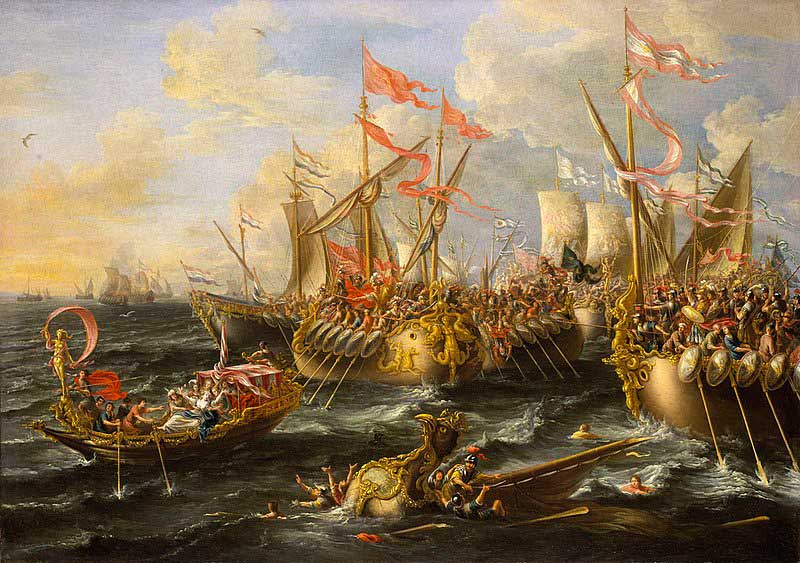
On the 2nd day of September, 31 BC, in the famous naval battle of Actium, Cleopatra personally led several dozen Egyptian warships into the fray, side by side with the fleet of Antony. However, in that raging battle on the west coast of Greece, the combined fleet of Cleopatra and Antony was completely routed by Octavian’s fleet. It is believed that before the onset of the battle, Quintus Dellius, one of the generals of Antony, defected to Octavian and briefed him about the details of Antony’s strategy. This may be a vital reason for the defeat, despite leading a larger army. In any event, Cleopatra and Antony were forced to break through the Roman line and flee to Egypt. While Cleopatra was in her safe refuge, Antony went off to fight his last battle. There, he was falsely informed that Cleopatra had committed suicide. It was too much for the distressed lover. He stabbed himself fatally and just before his death was informed that the news about Cleopatra’s death was a rumor.
Mark Antony was buried on the 12th day of August, 30 BC. After his burial, Cleopatra had a brief meeting with victorious Octavian, and then closed herself in her room with two of her maids. It is said that, she followed her lover by ending her life by being bitten by a poisonous snake, known as ‘asp’, a symbol of divine royalty. However, what happened behind those closed doors, are really unknown. The ancient biographer Plutarch pointed out that, Cleopatra was known to conceal a deadly poison in one of her hair combs and she might have used that potent toxin to end her life, with the help of the pin. The lovers were buried together, as they had wished, and Egypt became a province of the Roman Empire.


In an era when Egypt was in turmoil by internal and external battles, Cleopatra held the country together and proved to be as powerful a leader as any of her male counterparts. Though she was not an ethnically Egyptian, Cleopatra was the first member of the Ptolemaic line to learn the Egyptian language, and though she traced her family origins to Macedonian Greece, she embraced many of her country’s ancient customs,
The official Roman version of a predatory painted Cleopatra as an immoral woman. She was painted as a debauched temptress who used her sex appeal as a political weapon. It is a fact that, for political reasons, she styled herself as the reincarnation of the Egyptian goddess Isis. But, she was not as physically striking as commonly believed. Coins with her portrait show the lively facial expression of a lady, with a sensitive mouth, firm chin, liquid eyes, broad forehead, and a prominent nose, which is not that beautiful. According to Plutarch, her beauty was not altogether incomparable. However, it was her sweet melodious voice and irresistible charm that made her so desirable. Cleopatra was not really a stunning beauty, rather she was a captivating, persuasive and charming leader.
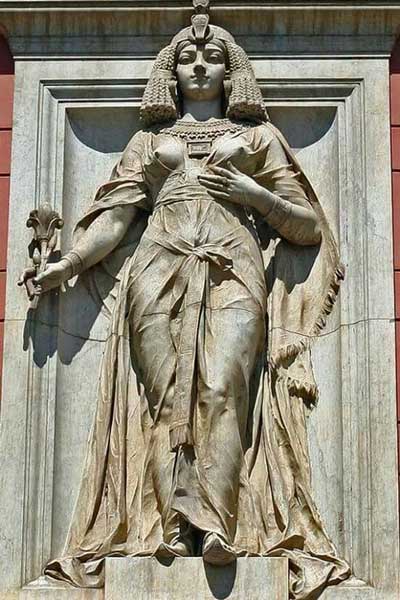
Cleopatra was well conversant in dozens of languages and was highly educated in difficult subjects like, mathematics, philosophy, oratory and astronomy. According to the Muslim scholars, writing after the Arab conquest of Egypt about 640 CE, Cleopatra was first and foremost a scholar and a scientist, a gifted philosopher and a chemist. In a papyrus dated 35 BC, Cleopatra is referred to as ‘Philopatris’, means ‘she who loves her country’.
Even after centuries following her death, the enigmatic life of Cleopatra and her affairs with the two powerful rulers of her time have ignited the lyrical inspiration of the artists, painters, storytellers and filmmakers of the world. Her affair with Marc Antony and its end became the inspiration for William Shakespeare’s play ‘Antony and Cleopatra’ (1607). In films the role of Cleopatra has been played by eminent actresses such as Theda Bara (1917), Claudette Colbert (1934) and Elizabeth Taylor (1963).
